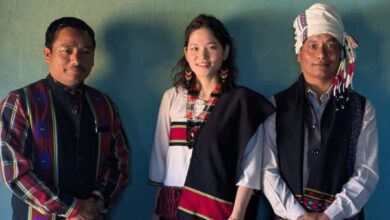The man who pioneered strawberry cultivation in Meghalaya
Ostander Lyngkhoi, a visionary farmer, made strawberries an important cash crop & trained many farmers in the state in cultivating the fruit

 Last month, the state government organised the Meghalaya Strawberry Festival in different districts. At an event during the festival, one of the government officials spoke about expanding the cultivation of the fruit from 25 acres to 100 acres in a year. At a time when the entire state is celebrating the success of this low-volume, high-value fruit crop, we should not forget the contribution of an individual to popularising strawberry cultivation here.
Last month, the state government organised the Meghalaya Strawberry Festival in different districts. At an event during the festival, one of the government officials spoke about expanding the cultivation of the fruit from 25 acres to 100 acres in a year. At a time when the entire state is celebrating the success of this low-volume, high-value fruit crop, we should not forget the contribution of an individual to popularising strawberry cultivation here.
Ostander Lyngkhoi started strawberry cultivation in 1998 when a friend introduced him to someone who was experimenting with the cultivation of the fruit in Cherrapunji. Leston Wanswait had procured a few saplings from Pune and planted them in his village.
However, the climatic conditions in Cherrapunji did not support the fruits and forced Wanswait to look for an alternative. During this time, Lyngkhoi met Wanswait, and together, they started strawberry cultivation in Byrnihat. It was a success, and that encouraged Lyngkhoi to plant strawberries in his village, Sohliya, under the Umsning block in Ri Bhoi.
The 75-year-old farmer, who is also the headman of Sohliya, was busy with a dorbar meeting on the day these correspondents visited him. The narrow but undamaged black-topped road leading to the village cuts through fields on both sides. There are stretches of tea plantation on one side that continue through Sohliya. A gate welcoming visitors to the village highlights what the village is famous for — strawberry and tea plantations, mountain biking and bird watching.
Sohliya, named after the eponymous indigenous fruit, is now more famous for strawberries.
Lyngkhoi took a break from the meeting session and took his guests to his strawberry garden, where over 15,000 plants were fruiting. He plucked a fruit as he entered the garden and casually took a bite before starting to talk about his journey.
“It was an experiment,” he said. “I am a farmer, so when my friend brought this plant to me, I wanted to plant it,” he replied when asked what made him cultivate strawberries.
High profitability
The fruits bring 50% profit, which is much higher than any other crop. This high profitability encouraged others in the village to start strawberry cultivation.
Speciality Marngnar (47) replaced vegetable cultivation with strawberries in 2010. “We would not earn much from vegetables. But strawberries provided us with a sustainable livelihood. Earlier, we would sell the fruits for Rs 400-500 a kg. However, prices have come down to Rs 200 now. Still, it is profitable,” she said.
The seeds are sown in autumn. Plucking begins in January and continues till May. “The fruits are plucked thrice a week. These are then sold to the local office of the Horticulture Department. Sometimes, we sell the fruits directly to Bah Ostander, who then sells them to buyers in Guwahati,” said Marngnar.
Now, villagers grow vegetables for self-consumption.
Strawberry seeds are high-priced at Rs 17 apiece. But Marngnar said they procure the seeds from a self-help group in the village.
Lyngkhoi produces about 2 tonnes of strawberries each year and sells them to buyers in Guwahati.
Lyngkhoi’s journey
Lyngkhoi is originally from Pariong in West Khasi Hills. He started his career as a wireless operator in the Meghalaya Police Department. His initial postings were in Sonapahar in West Khasi Hills and Shillong.
An enterprising individual, Lyngkhoi wanted to start his own venture. So, he quit his job and started farming. He shifted to Sohliya village and started growing paddy, maize and tea.

After the success of strawberry cultivation in Byrnihat, he introduced the fruits to his village in 2002. Initially, he sold the fruits in bamboo baskets on the highway. Soon, he received a good response and expanded his cultivation. He roped in other villagers to grow more strawberries.
In 2004, he formed the Strawberry Growers’ Association and received government support under the Technology Mission. He procured seedlings from California. Production saw an impressive growth between 2006 and 2008.
Now, about 50 households in the village cultivating strawberries produce about 8 tonnes of the fruit each year.
Lyngkhoi has trained farmers in about 60 villages in the state in growing strawberries. He has also taught them how the fruits are packaged before they are sold in the market.
Resperlin Lyngkhoi, a strawberry grower at Sohliya, said that besides selling the packaged fruits, farmers are also diversifying into other marketable products such as wine, jam, dehydrated strawberries, etc.
Lyngkhoi said he was grateful to the state government for helping farmers expand production and get training.
The government provides seeds, the infrastructure for drip irrigation, Syntex water tanks and packaging, among others. “The help is sufficient for farmers, but in the end, it is their hard work that will count,” said the experienced strawberry grower.
Lyngkhoi emphasises the importance of developing a seed bank in Meghalaya because “the seeds here are very good”. This will help local farmers procure the strawberry seeds at a cheaper rate and help them cultivate high-quality fruits.
Lyngkhoi is a visionary farmer who transformed the lives of farmers in Sohliya village. His expertise and experience, innovative ideas and insights can be utilised to make Meghalaya one of the important strawberry-growing states in the country and a key exporter of the fruit in the North East.
(With inputs from Nabamita Mitra)





